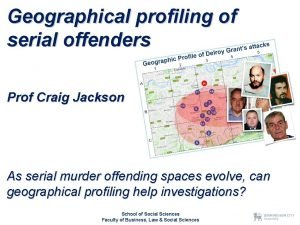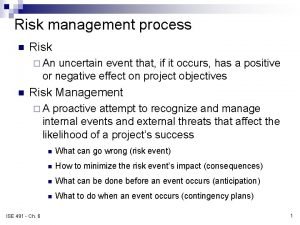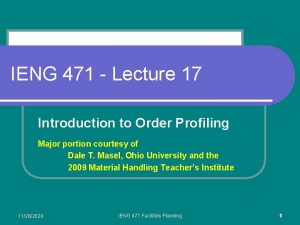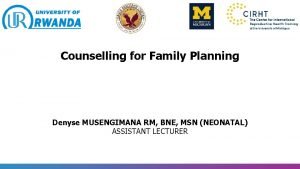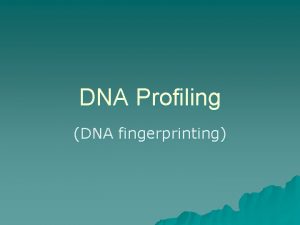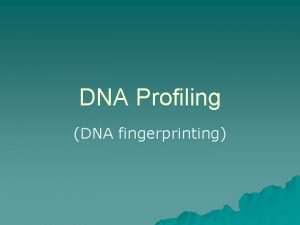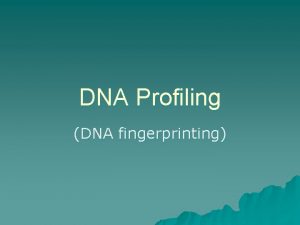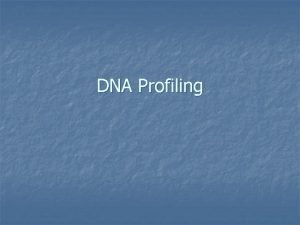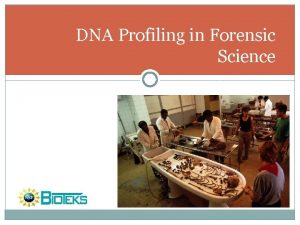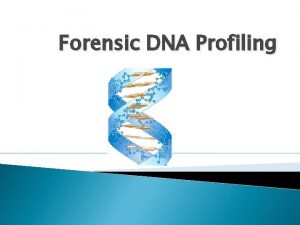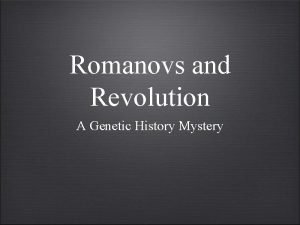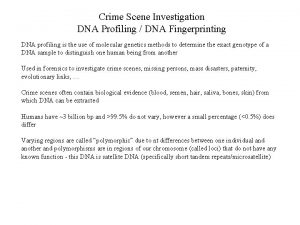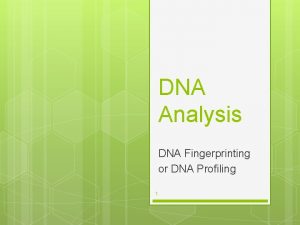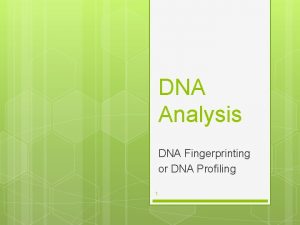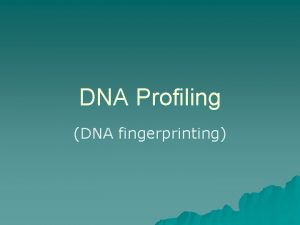DNA Profiling the mystery of the romanovs Dr






























- Slides: 30

DNA Profiling the mystery of the romanovs Dr. G. Mathan

DNA profiling Definition: Characterization of one or more relative features of an individual ‘s hereditary make up. DNA Profile: A pattern of bands usually developed on a radiograph or an X-ray film. Principle: Ø Polymorphisms: determining which polymorphism a person has at the highly variable region. Ø Identical DNA structure within all tissues of the same body: identical DNA in semen, saliva or hair cells.


Profiling techniques DNA profiling uses a variety of DNA typing systems: ü RFLP typing ü STR typing ü mt. DNA analysis ü HLA typing ü Gender typing ü Y-chromosome typing

RFLP analysis Basics: • Introduced by Alec Jeffreys in 1985. • RFLPs are variations within specific regions of genomes 2050 bp long. Technique: i. DNA is digested by restriction enzymes. ii. Gel electrophoretic separation of fragments. iii. Gel and fragments exposed to HCL for depurination. iv. DNA transferred to nylon membrane.

v. Minisatellite regions examine radio-labeled probes. vi. Autoradiography of the radio-labeled membrane. vii. Successive regions are examined. viii. Distribution of the probed RFLPs are estimated from a population database. Advantage: High variability. Drawbacks: Large fragments are difficult to be distinguished on the gel. Large quantities of highly purified DNA is required.


Str analysis Basics: • Most often employed profiling technique of the day and based on PCR. • STRs are repetitive elements 2 -6 bp in length. • Different STR sequences occur at different loci. Positions are fixed but no. of repeating units varies from 4 -40. Technique: i. STR loci is targeted with sequence specific primers. ii. Amplification using PCR.

iii. Resulting DNA fragments are separated and detected by electrophoresis: capillary or gel. iv. Statistical analysis and discrimination. Advantages: Small quantities of DNA is sufficient (1 ng). Faster, less laborious and can be automated. Drawbacks: If sample is degraded there will be improper amplification. Sample may contain substances that hinder PCR reactions.


Electrophoresis for Str typing Capillary Electrophoresis Ø DNA fragments subjected under electric field in a thin glass capillary tube. Ø Detection is using fluorescent dyes. Ø Size standard are assigned to determine the no. of repeats. Ø Costly. Ø Ø Gel Electrophoresis Works on same principle as CR but polyacrylamide gel is employed. The entire gel is scanned onto computer and image showing all bands is got. No need for size standards since the allelic ladder is run alongside the samples. Cost-effective.



codis • Combined DNA Indexing System • Put forward by the FBI • 13 STR loci studied or reference and discrimination.

Dna profiling in forensics In forensics, DNA profiling techniques is employed to arrive at conclusions for all criminal cases. The main uses are: a) Identifying possible suspects. b) Clearing wrongly convicted criminals. c) Closing the case of missing individauls. d) Establishing paternity and familial relationships. e) Identifying victims of a natural disaster or in case of mass damage.

How do crime scene investigators create a DNA profile? 1. Evidence is collected at the crime scene: Blood Tissue Semen Teeth Urine Hair Saliva Bone

2. DNA is extracted from sources at scene and from victim and suspect

3. DNA samples are processed Sample Obtained from Crime Scene or Paternity Investigation DNA Extraction Biology DNA Quantitation PCR Amplification of Multiple STR markers Technology Separation and Detection of PCR Products (STR Alleles) Sample Genotype Determination Genetics Comparison of Sample Genotype to Other Sample Results Generation of Case Report with Probability of Random Match If match occurs, comparison of DNA profile to population databases

Power of Discrimination Crime scene investigators use techniques that are fast, cost effective, and have a high Power of Discrimination high RFLP analysis STR analysis mt. DNA Blood group typing low slow fast Speed of Analysis

the romanovs • The Romanovs were the last Russian Monarchy. • Family was made up of: Tsar Nicholas II Tsarina Alexandra Daughters: Olga, Tatiana, Maria and Anastasia. Son: Alexei

Story in short Ø The Tsar was abdicated of his throne following which the royal family along with four loyal members was taken into exile by the enemies. Ø On July 17, 1918 the family along with the others was executed by a firing squad. Ø The remains were processed and abandoned in a mine shaft. Further, the bodies were transported to an open field a few kilometers from the mine. Ø Thus the fate of the romanovs became a mystery waiting to be solved.

Discovery and investigations of the first mass grave • In late 1970 s, Dr. Alexander Advonin located the mass garve containing the remains of the romanovs. • There were 950 bones obtained from the grave which were organised into 9 skeletons. • Further investigations on the 9 skeletons were performed by DNA analysis exp. Conducted by Dr. Peter Gill and Dr. Pavel Ivnov. • Sex and familial relationship was established by the anatomical study and STR anlysis. • Mt. DNA testing confirmed maternal relationship between Prine Philip and the Tsarina. This was also useful in relating the 3 daughters of the royal couple.


• Maternal relatives of the Tsar, were used for reassociation of the remains of Tsar. • A single point heteroplasmy at position 16169 was observed in mt. DNA of the Tsar. This was seen in his relatives too. • To confirm the authenticity of the heteroplasmy, the remains of the Tsar’s own brother, Grand Duke Georgii Romanov were analysed. • He shared the same heteroplasmy but with a different ratio. • This helped in the confirmation of the presence of the remains of the Tsar and tsarina in the grave and helped in the establishing of the family tree.


Anna anderson • Since the romanovs were missing many people claimed to be one of the missing children. • The most interesting case was that of Anna Anderson, who claimed to be the youngest daughter of the Tsar, Anastasia. • With the discovery of first grave and subsequent DNA analysis, Anna Anderson was exposed as an imposer.

Discovery of the second grave • In summer 2007, a group of archaeologists discovered few bone fragments approximately 70 mts from the first grave. • A set of 44 bone fragments and teeth were recovered from the site under the guidance of Dr. Sergei Pogovelov. Conclusions obtained by analysis: a) Duplicative anatomical units : two people were present among the recovered remains. b) Sciatic notch dimension: one of them was a female, 5 -9 yrs of age; another was a male, 12 -15 yrs age.

Confirmatory tests • mt. DNA analysis can be considered conclusive. The new samples matched exactly with the mt. DNA data of Tsarina Alexandra and a living relative. • Autosomal STR genotypes were developed to form a family pedigree. The DNA profiles of the new samples perfectly fit into the family tree of Tsar and Tsarina. • 17 Y-STR haplotype remains of the Tsar, his son and a living romanov relative were perfectly in match. These results taken together agrees with the hypothesis that the samples recovered from the second grave was the missing children, Anastasia and Alexei of the royal couple. Thus the missing children were found back!!

Thank you

Acknowledgement v The Presentation is being used for educational and non commercial purpose v Thanks are due to all those original contributors and entities whose pictures used for making this presentation.
 Dna polymerase function in dna replication
Dna polymerase function in dna replication Dna rna protein synthesis homework #2 dna replication
Dna rna protein synthesis homework #2 dna replication Bioflix activity dna replication lagging strand synthesis
Bioflix activity dna replication lagging strand synthesis Coding dna and non coding dna
Coding dna and non coding dna The principal enzyme involved in dna replication is
The principal enzyme involved in dna replication is Top down profiling
Top down profiling Google wide profiling
Google wide profiling What is character profiling
What is character profiling Competency profiling
Competency profiling Farmer profiling
Farmer profiling E profiling
E profiling Delroy grant psychology
Delroy grant psychology Qnx memory usage
Qnx memory usage Klasifikasi jabatan
Klasifikasi jabatan Performance profiling techniques
Performance profiling techniques Activity profiling
Activity profiling Ase profiling
Ase profiling Risk event graph explanation
Risk event graph explanation Typological profiling
Typological profiling Lighthouse profiling
Lighthouse profiling Brianmac scat test
Brianmac scat test Leadership profiling tools
Leadership profiling tools Disadvantages of learner profiling
Disadvantages of learner profiling Column profiling
Column profiling Youtube.com
Youtube.com Skus
Skus Channel partner profiling
Channel partner profiling Duplex fixture
Duplex fixture Counselling gather approach
Counselling gather approach The trailside killer
The trailside killer Spokesperson profiling
Spokesperson profiling











